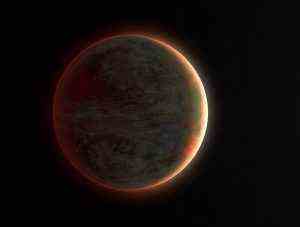Clouds of corundum, rain of liquid metal and extreme storms: astronomers have for the first time gotten a glimpse of the weather processes on an exotic planet – hot Jupiter WASP-121b. This exoplanet is so close to its star that even its nightside is 1,500 degrees hot. Clouds of molten droplets of corundum and perovskite form there, and it rains molten metal, the team reports in Nature Astronomy.
Hot Jupiters are among the extremists among exoplanets: These gas giants orbit their stars so closely that their dayside atmosphere reaches several thousand degrees. Under these conditions Molecules torn and even metals in gaseous form. Some of these infernal planets are even so hot that they shine by themselves. The night side of these planets, on the other hand, is significantly cooler. Nevertheless, even there the heat is still sufficient to Liquid iron rain and Titanium dioxide snow to create.
So far, however, observations of such hot Jupiters have always provided only rough snapshots of their gas envelope and the conditions prevailing therein.
First look at day and night side
Astronomers led by Thomas Mikal-Evans from the Max Planck Institute for Astronomy in Heidelberg have now succeeded for the first time in gaining a more complete picture of the weather on such a hot Jupiter. The team’s sights were on exoplanet WASP-121b, 855 light-years away, a hot gas giant about twice the size of our Jupiter. With an orbital period of 30.6 hours, the planet orbits its star extremely closely, always facing the same side.
“To study the entire surface of WASP-121b, we used Hubble to record spectra during two complete planetary orbits,” explains co-author David Sing of Johns Hopkins University in Baltimore. This allowed the team to map the composition of the upper atmosphere and its temperature on both the day and night sides. This provides the first comprehensive picture of how the gas envelope of such an exoplanet functions as a global system.
Clouds of precious stones and metals
The spectral analyzes revealed: On the day side, WASP-121b gets hotter than 2,700 degrees. This is hot enough to tear apart even water molecules and vaporize metals. On the night side, on the other hand, the temperatures drop to a good 1,200 degrees. “This is cool enough for iron, vanadium, calcium and magnesium to condense out,” the astronomers report. Accordingly, these metals form glowing droplets, some of which remain in suspension and some fall as rain.
But there are other exotic clouds on the night side of this planet: spectral data show that there are also droplets of minerals such as peroswkite (CaTiO3), forsterite (Mg2si3) and corundum (Al2O3) – Corundum is the mineral that makes up rubies and sapphires. These “liquid gems” also form clouds on the hot gas giant and rain down from the sky at night.
The observations also showed that the water molecules that were torn apart on the day side recombine on the night side and form water vapor.

Storms drive metal and co around the planet
But this nocturnal cloud formation is not a one-way street: while some models suggest that condensed metals on the night side rain down to lower regions and thus disappear from the upper gas envelope, the spectral data of WASP-121b showed otherwise: they are at the transition from the night to the day side there are still enough metallic floating droplets in the upper atmosphere to evaporate there again.
One explanation for this could be the strong winds on the hot exoplanet: The enormous temperature difference between the day and night side causes storms to race around the planet at more than five kilometers per second – this corresponds to 18,000 kilometers per hour. “These winds are far faster than our jet stream and could sweep the clouds around the entire planet in just 20 hours,” says co-author Tansu Daylan from the Massachusetts Institute of Technology (MIT).
These raging winds could sweep the liquid metal and gem droplets from the nightside to the dayside before raining out completely. On the day side, these metals then vaporize again and become gaseous. Conversely, the storms propel hydrogen and oxygen atoms to the nightside, where they recombine to form water.
Meteorology of an extreme world
“This gives us a global view of the meteorology of an exoplanet for the first time,” says Mikal-Evans. In the case of the hot Jupiters, however, the extreme contrasts between day and night ensure far more extreme and exotic weather conditions than we are familiar with from the planets in our solar system.
Astronomers hope that observations from the James Webb Space Telescope will soon reveal more about WASP-121b’s atmosphere and weather. It is already planned to target this exoplanet in the first year of operation of the new telescope. Its infrared optics could also provide more information about the nature of the deeper layers of the planetary gas envelope and how fast the winds are blowing there. (Nature Astronomy, 2022; doi: 10.1038/s41550-021-01592-w)
Source: Max Planck Institute for Astronomy, Massachusetts Institute of Technology

